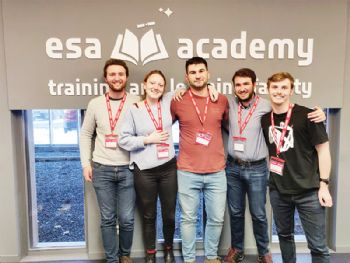
Engineering students from the University of Brighton have been learning valuable skills at the European Space Agency (ESA) Academy’s training and learning facilities in Belgium.
The five students spent four days at ESEC-Galaxia (in Redu) in preparation for testing their cutting-edge technology in zero-gravity conditions later this year.
During their time in Belgium, the students — team PHP Cubed — took part in space-based activities that included ‘walking on the surface of the moon’ (via a virtual-reality head-set).
The experience enabled the team members to develop skills including project management, system engineering principles and space science.
PHP Cubed (
www.php-cubed.com) is one of just two teams in Europe that will test their technology on NoveSpace’s parabolic-flight platform as part of the European Space Agency’s educational ‘Fly Your Thesis!’ programme.
Team member Liam Ardagh said: “Our time at the ESA Academy in Redu has given us information that is essential to the progress of our project.
“Interacting with experts from not only ESA but also from NoveSpace has been an amazing experience. Now we look forward to the flights.”
PHP Cubed’s project will test a passive heat management system, scaled down for a nanosatellite application.
If successful, it will allow sensitive components to be cooled and temperatures to be managed without the need for a power supply or moving parts — a crucial factor in minimising the weight and size of nanosatellites, which can weigh as little as 1kg.
Georgie Crewdson said: “This project has huge scientific potential, and the data we collect may change the way we design nanosatellites and contribute to the innovation of space tech design.
“Our experiment will also provide a legacy for future students to build upon and innovate even further.”